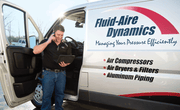If you require ultraclean compressed air in your processes, it is important to reduce oil carryover in your compressed air system as much as possible. While oil-free air compressors may be recommended for some applications, in most cases, it is possible to get oil-free air from oil-flooded compressors using the right combination of air treatment and filtration. Here’s what you can do to minimize oil carry over from an oil-flooded rotary screw or reciprocating compressor.
Watch 6 Steps to Reduce Oil Carryover
Understanding Oil Carryover in Compressors
Oil carryover occurs when oil that is used to lubricate, seal and cool the air end of an oil-flooded rotary screw compressor mixes with the compressed air and is not adequately separated before the air is delivered to the system. This results in oil particles being carried along with the compressed air into the downstream air network.
Common Causes of Oil Carryover
Oil carry over can occur for a number of reasons, including:
- Inadequate separation of oil in the oil separators.
- Overfilling the compressor oil, resulting in high oil levels in the oil reservoir.
- Blocked or inefficient oil return line (scavenge line).
- High operating pressures or temperatures beyond the air compressor operating specification.
- Low operating pressure or low duty cycle.
- Oil degradation or contamination.
- Aging or damaged air compressor parts, such as worn seals or bearings.
The Risks of Overfilling Compressors with Oil
Overfilling oil-flooded air compressors with oil can lead to several detrimental effects.
- Excess oil is more likely to escape into the compressed air stream, leading to contamination of air lines, tools and processes that rely on clean, oil-free air.
- As oil accumulates in air filters and air lines, it can restrict airflow, leading to excessive pressure drop, higher energy costs and reduced longevity for inline filters.
- Overfilling may damage the oil system or other compressor components, including bearings and seals, which may lead to premature wear and failure.
Oil’s Role in Oil-Flooded Screw Compressors

In oil-flooded screw compressors, oil is injected into the compression chamber to seal, lubricate and cool the components. In oil-flooded rotary screw compressors, the oil serves multiple essential functions:
- Lubrication to reduce friction in moving parts like rotors and bearings.
- Cooling to maintain stable temperatures and prevent overheating.
- Forms a seal in compression chambers to minimize air leaks.
- Dampens operational sounds, leading to quieter operation.
- Coats internal components, guarding against rust and corrosion.
Learn more: Full Guide to Rotary Screw Air Compressors.
Benefits of Oil-Free & Clean Compressed Air
Oil-free air offers significant benefits, particularly in sensitive environments where clean air is essential to maintain product purity and comply with industry standards. Clean, oil-free air reduces the risk of oil contamination in sensitive products or processes, such as pharmaceuticals, food processing, and electronics manufacturing.
Comparing Oil-Free and Oil-Flooded Compressors

Oil-free compressors, unlike oil-flooded compressors, do not use oil in the compression chamber (air end), eliminating the risk of oil contamination in the compressed air. This makes an oil-free compressor ideal for industries requiring high air purity. Oil-flooded compressors, however, typically provide higher efficiency and longevity but require more downstream filtration to ensure air quality.
Read more: Lubricated vs. Oil-Free Compressors.
How Is Oil Removed from Inside an Oil Flooded Compressor?
Oil is removed from an oil-flooded compressor through a combination of the oil/water separator and inline filtration.
- Internal to the compressor is an air/oil separator. This device removes oil from the compressed air discharge so that the air has less than 3 PPM of oil in it.
- Inline filtration takes care of the rest of the oil in the air stream. A combination of coalescing and activated carbon filters can reduce oil carryover to 0.002 PPM, which is more than adequate for most applications.
- Years ago, the oil separator was a common failure point for lubricated air compressors. However, with modern designs, that is rarely an issue anymore. An air receiver tank can be added after the compressor to act as a failsafe to prevent oil from reaching downstream filtration and the air distribution system in the unlikely event of a failure.
Practical Strategies for Reducing Oil Carryover
There are several steps that you can take to minimize oil carryover in an oil-flooded screw compressor.
1. Regular Maintenance of Your Air Compressor

The intake filter is your first line of defense against contaminants in your compressed air supply. The intake filter will remove large particulates and some oil mists from atmospheric air entering the air compressor. Regular replacement of your intake filter, oil filter(s), oil, and air/ oil separator element(s) is the first step in preventing excessive oil carryover.
2. Use Inline Filtration to Remove Oil and Particulates from Compressed Air
The inline filters for sale do most of the work in reducing oil carryover from an oil-flooded air compressor.
- A high-efficiency coalescing inline filter removes particulates down to 0.01 microns and has a maximum oil carryover of 0.008 PPM.
- Activated carbon inline filters remove hydrocarbon mists, vapors, and odor with a maximum oil carryover of 0.002 PPM.
With these filtration efficiencies, there is very little meaningful difference in compressed air quality between an oil-free compressor and an oil-flooded air compressor. In fact, inline filtration for an oil-flooded air compressor may be more efficient than a filter used with an oil-free compressor, because the filters work best when they have some oil in them. Change inline filters at least once a year or after 4,000 hours of operation.
Read more: Everything You Should Know About Inline Filtration.
3. Use an Oil/Water Separator

The oil/water separator is used to separate lubricants from condensate generated by the air compressor. The oil/water separator removes excess oil from the compressed air condensate and allows for proper disposal of liquid wastes according to EPA guidelines. The oil/water separator must be properly maintained, and filter cartridges should be changed at least annually.
Read More: Oil/Water Separators for Compressed Air Systems: Complete Guidelines.
4. Test Your Air Supply Monthly
If ultraclean air is a necessity, make sure you test your compressed air supply at least monthly to make sure oil carryover isn’t rising. If you start to see an uptick in oil carryover (measured in PPM), check your inline filtration. It may be time to replace the filters.
Can You Get Oil-Free Air from an Oil-Flooded Air Compressor?
Can an oil-flooded air compressor be used for applications requiring ultraclean compressed air? In most cases, the answer is yes. Fluid-Aire Dynamics can help you transition from oil-free to oil-lubricated air compressors with high-efficiency filtration. We helped one manufacturer make the switch nearly 30 years ago — and their air has passed every air quality test since.
Want to know which kind of air compressor is right for you? Talk to a compressed air expert at Fluid-Aire Dynamics. Call or contact us online.





